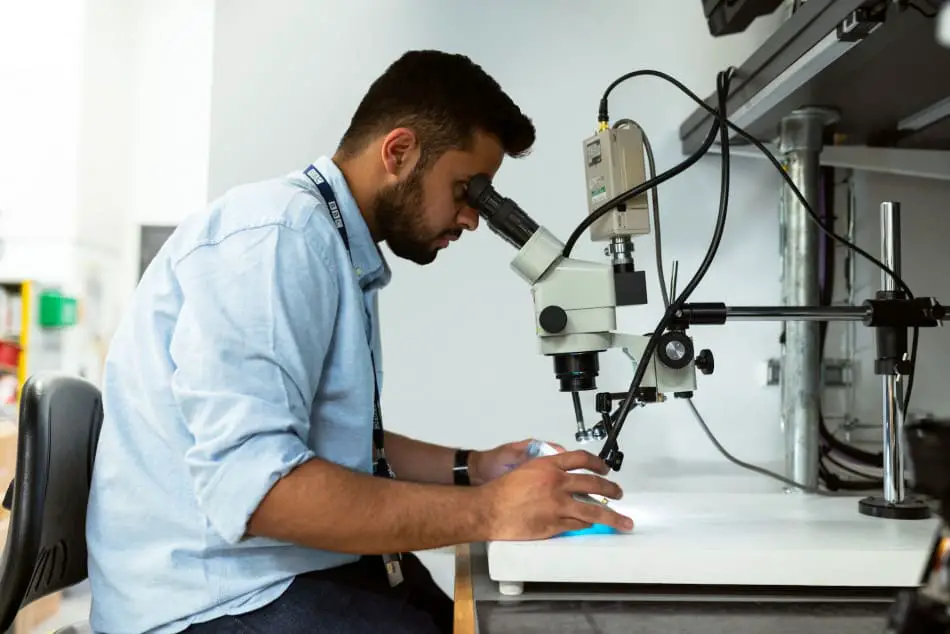Neuroscience is a broad subject that studies the nervous system and the brain. However difficult as studying by yourself it may sound, it is doable, and this article aims to break things while showing you how to learn the subject from scratch.
To self-study neuroscience, you must narrow down your focus. An excellent way of achieving this is through the use of spaced repetition. Another trick is, instead of memorizing, apply all you learn while studying the subject to other disciplines. Thankfully, there are loads of great textbooks and self-study resources on sites like Amazon.
Since the brain is the most important organ in the body, studying to become a neuroscientist isn’t going to be a ride in the park.
So here, we’ve packed resources and provided helpful information that will aid you as you study neuroscience on your own.
8 Important Tips to Successfully Study Neuroscience on Your Own
We understand how you might think studying neuroscience involves dissecting the brain and identifying various parts of the nervous system; however, this is not the case.
The study of neuroscience entails understanding how the different brain parts are linked and how this link impacts one another.
Here are a few pointers to effectively help you study neuroscience.
-> Read Also What Is An Autodidact?
1. Grasp all the Fundamentals of Neuroscience

Like several disciplines, you cannot study neuroscience without properly understanding the basics.
The fundamentals of neuroscience include the physiology and anatomy of the nervous system, and a proper understanding of this will take you to the heart of the course and ensure that you understand the scope of its content.
Fundamentals you should get familiar with for any neuroscience prerequisite include:
- Brain and central nervous system anatomical structures.
- Nuclear function and cellular messaging systems.
- Fundamentals of bioelectricity
- Neuron communication and synaptic transmission.
- How sensory perception works in the brain.
- Neuroscience in everyday life.
Once you have a good grasp of these fundamentals, you’re ready to tackle advanced topics in neuroscience.
Helpful online resources to grasp the fundamentals:
- 2-Minute Neuroscience: The Neuron
- Intro to Neuroscience
- Fundamental Neuroscience (Squire, Fundamental Neuroscience) 4th Edition, Kindle Edition
- Neuroscience Basics: A Guide to the Brain’s Involvement in Everyday Activities 1, Larimore, Jennifer L. – Amazon.com
2. Draw out a Detailed Plan
The most important bridge to cross when self-studying is filtering the noise and picking up what is useful.
This might seem trivial, but trust us, you would be better off knowing where you are headed and what is expected of you before throwing yourself into neuroscience, especially in this age and time of information overload.
Having a set-out plan also includes knowing what kind of neuroscience degree to pursue, how long it would take to achieve your desired degree, and the relevant coursework and requirements.
3. Don’t Try to Do Everything All at Once
Now that you have a detailed plan and an idea of how long it will take to complete your self-study of neuroscience. It would be best if you remembered to take things slowly.
The best way to grasp the neuroscience concept is to study it regularly. Also, remember that it takes a typical undergraduate 4-5 years to earn a bachelor’s degree and a master’s student 2-3 years of study.

4. Test Yourself Under Exam Conditions Beforehand
If you plan on sitting for an exam like the European Board of Neurology exams, or NeuroSAE exams, it is never a good idea to leave things until the last minute and then try to cram everything in at once.
This is because studying this way does not give room for the consolidation process.
Examine yourself in the same manner and under the same conditions as you would in an exam. This enables you to evaluate your performance and predict the outcome of your exams more efficiently.
Practicing also allows you to identify which areas you are already familiar with and which you need to improve on.
When taking an exam, you only have to recall information from memory. This information would be easy to find because your research method has already replicated your experience.
As a result of all of this, you will perform better on your tests and exams.
A couple of handy online neuroscience quizzes include:
- 18 Neuroscience Quizzes Online, Trivia, Questions & Answers
- Test Your Neuroscience Know-how – ProProfs Quiz
5. Exercise and Eat Regularly to Improve Brain Function
You may believe these factors have nothing to do with your ability to retain information but believe me, they do.
Studies indicate that physical activity and fitness improve learning by flooding the brain with growth hormones. So, if you enjoy working out, it may be beneficial to study right after.
Your brain, like all machines, requires fuel to perform its daily functions. Good nutrition nourishes the brain and allows it to work more efficiently.
Additionally, keep in mind to take breaks to avoid burnout. Sleeping is the most effective way to rest the brain. It allows the brain to create new mechanisms and connections for faster learning.
6. Avoid Memorizing Things Blindly
This is another key thing to note while self-studying neuroscience. Memorizing without understanding the context can turn out badly.
To gain a better understanding, you must first understand the context of each neuroscientific concept and then memorize it in a way that will ultimately help you understand the topic.
Finally, adopt neuroscience study habits and apply the fundamentals to real-world scenarios.
7. Use Spaced Repetition to Help You Remember Things Better
The human brain stores information in its short-term and long-term memory units. When we learn something new, it is stored in our short-term memory.
Short-term memories are only retained for about 30 seconds before being forgotten.
To store new information in long-term memory, we must rehearse it repeatedly during short-term memory retention periods. This makes it easier to recall information when it is required.
To learn abstract neuroscience concepts, your brain must switch from short-term to long-term memory with spaced retention.
8. Find Out What Works for You and Stick to It!
There is no universal guide to self-studying neuroscience. Ultimately, it all boils down to you, your thought processes, and how you assimilate things.
Therefore, it is crucial to find a reading routine that works for you and stick with it.
However, the above guidelines can lead you to discover the best methods and practices to enhance your study.
Having successfully established ways to self-study neuroscience, this begs the next question.

Online Resources for Self-Studying Neuroscience
As with other medical courses, studying neuroscience means dealing with bulky textbooks. While these textbooks are extremely helpful, many other online books would give you a deeper understanding of the studied topics.
If you’d like to go through an entire college curriculum, here’s a self-study neuroscience curriculum you can use.
Useful textbooks for self-studying neuroscience include;
- Roger Carpenter’s ‘Neurophysiology: A Conceptual Approach
- Neuroscience: Exploring the Brain, Fourth Edition by Mark F. Bear, Barry W. Connors, Michael A. Paradiso
- Kandel et al.: Principles of Neural Science
- Neuroscience by Dale Purves, George J. Augustine, David Fitzpatrick, William C. Hall, Anthony-Samuel LaMantia, Richard D. Mooney, Michael L. Platt
- Carlson: Physiology of Behavior
- Hille: Ion Channels of Excitable Membranes
- Kalat: Biological Psychology
- Bloom, et al.: Brain, Mind, and Behavior
- Nicholls, et al.: From Neuron to Brain
- Shepard: Neurobiology
If reading bulky textbooks is not your thing, don’t fret. There are other avenues to learn neuroscience. These include videos, blog posts, and sometimes, medical journals.
Some self-learning Neuroscience websites that could aid you include:
- Careers and Jobs in Neuroscience | Stoodnt.
- Fundamentals of Neuroscience, Part 1: The Electrical Properties of the Neuron | edX.
Certain videos explain basic things you need to know about studying neuroscience. Additionally, you can always source videos to watch on unclear course topics to aid your understanding of those topics.
Learning with videos creates a vivid audio-visual learning experience, and information obtained this way is easily retained.
Some helpful neuroscience video guides include:
- Things I wish I’d known about studying neuroscience
- Intro to Neuroscience
- HOW I STUDY *EFFECTIVELY* (study tips from a neuroscience student)
- BBC Breakfast piece on the INSTEP trial
Career Paths Available to Neuroscientists

After learning how to self-learn neuroscience, the degree and specialization of one neuroscientist may differ from another.
You can go for a bachelor’s Degree, a Ph.D., or an MD, depending on the kind of neuroscientist you want to be.
For example, you could work as a doctor who treats patients or a neuroscientist who publishes research and studies how the brain develops.
There are different career paths to decide on as a neuroscientist, some of which you would like to consider are:
| Branches of Neuroscience | Specializations |
| Cognitive Neuroscience | Neural substrates of mental cognition processes; the intersection of psychology and neuroscience. |
| Affective Neuroscience | Mechanics of neural emotions, relationships, and communication. |
| Behavioral Neuroscience | Mental processes and behavior in humans and non-humans. |
| Cellular Neuroscience | Study of neurons, morphology, and neurotransmitters at the cellular level. |
| Clinical Neuroscience | Science of mental diseases and brain disorders |
| Computational Neuroscience | Constructs neurotransmitters and neuronal circuit models that comprise the brain to understand better and define its capabilities. |
| Cultural Neuroscience | Investigates psychological, neural networks, and genomic processes to understand cultural variations. |
| Developmental Neuroscience | A broad range of disease-related biological processes in varied species to understand complex molecular and brain developments. |
| Molecular Neuroscience | Advanced understanding of genetic processes in general by studying the nervous system, neurological function, and disorders. |
| Systems Neuroscience | Investigates the interactions of neural structures in networks that affect sensorimotor control and information processing. |
| Social Neuroscience | Map the neural substrates of social behavior, where they may reside, and their corresponding connections to other brain parts. |
| Neuroeconomics | Combines information from behavioral economics with research on neuroscience and identifies how neuroscience affects economic decision making |
| Neuroengineering | Design and implement digital circuits and communication devices for rehabilitation and treatments for patients suffering from severe brain damage. |
| Medical Neuroscience | Seeks understanding of the basis of medical symptoms and disorders through integrating physiology, molecular biology, and genetics. |
Table sourced from https://en.wikipedia.org/wiki/Outline_of_neuroscience
Even though there are numerous branches into which you can delve, there are multiple job opportunities in varied industries for Neuroscience degree holders of your job preference.
3 Reasons Why You Should Study Neuroscience on Your Own
As much as we don’t want to scare you off, the plain truth is that studying neuroscience is no child’s play, especially now that you’ve decided to do it on your own.
However, since you are determined to do it, here are some reasons to proceed with your self-learning journey.
1. High Cost of Tuition
The financial cost of obtaining a neuroscience degree is a significant barrier for prospective neuroscience students.
An undergraduate neuroscience degree is quite expensive, requiring many years of tuition and thousands of dollars in student fees.
Even for self-study in neuroscience, you will need to invest in a series of courses necessary for any advanced degree program in this field.
According to a college tuition study, the average tuition and fees for the schools’ Neuroscience programs for the academic year 2021-2022 are $40,322 for out-of-state students and $11,704 for in-state students, making these programs hard to afford for the majority of students.
Prospective students who enroll in the Neuroscience program must commit at least four years of their lives and tens of thousands of dollars.
Due to the high cost of this degree program, many students drop out, making it impossible for them to graduate.

2. Strict College Requirements
The competition for admission to Neuroscience is fierce, and the student admission ratio is usually low. The requirements for undergraduate and graduate neuroscience degrees vary by college. However, there are a few common requirements.
Most undergraduate colleges require students to complete prerequisite courses, graduate programs require advanced courses, and some institutions require a thesis, research paper, or internship before admission.
Listed below is a rundown of typical prerequisites for undergraduate and graduate programs in neuroscience.
| Undergraduate Prerequisite Courses | Graduate Requirements |
| Biology | Bachelor’s degree from an accredited institution |
| Chemistry | A college GPA between 3.0 – 4.0 |
| Physics | Experimental Psychology |
| Mathematics | Biochemistry |
| Statistics | Research experience |
| Psychology | Thesis Report |
3. Long Number of Years Required to Become a Licensed Neuroscientist
Besides battling the enormous costs of obtaining the degree, the duration of time to receive your required degree could also be discouraging. A student could stay in school for up to 10 years before obtaining a Ph.D. in neuroscience.
To earn a degree in Neuroscience, here is a quick breakdown of how long it would take, according to collegerealitycheck.com.
| Degree Type | Duration (Years) |
| Undergraduate | 4 – 5 |
| Graduate | 5 – 7 |
| Average | 9 -12 |
The lengthy time required to study and eventually practice neuroscience has discouraged many students from pursuing it.
-> Learn More about Self-Learning vs. Classroom Learning: Which Is Better?
Difference Between a Neuroscientist and a Neurosurgeon
As previously stated, we’ve often found that the average layperson will mistake a neuroscientist for being the same as a neurosurgeon.
In this section, we would like to clear the air and spell out the differences between these two professionals.
For one, Neuroscientists are concerned with researching the human brain and nervous system.
They conduct research on brain structure and function, develop data-driven theories, and apply their findings in investigating cognitive processes at all levels, from the most basic to the most complex systems.
In contrast, neurosurgeons directly perform surgical procedures on the human brain and nervous system to treat neurosurgical diseases such as tumor and brain infection removal.
The primary distinction between the two is that neuroscientists research the nervous system.
In contrast, neurosurgeons perform surgery on the brain and nervous system with their own hands.
Frequently Asked Questions (FAQs)

Q: Is Studying Neuroscience on My Own Hard?
Studying neuroscience on your own can surely be intimidating. However, using the right resources and following through with a well-detailed study plan makes things much easier.
Q: What is Neuroscientific Research?
Neuroscientific research addresses methods to better understand the neural networks that comprise how the brain functions and how that function is affected by things like behavior and external stimuli.
It encompasses psychological neuroscience, behavioral neuroscience, cognitive neuroscience, and neuroimaging.
Q: What Are the Differences Between Neuroscience, Neurology, And Neurophysiology?
Neuroscience is the umbrella term of all neurological disciplines. It is the brain’s structure, and nervous system functions focused on the physiological underpinnings of behavior.
Neurology, on the other hand, is a subfield of neuroscience that uses neurological science principles to define and diagnose problems in patients with brain disorders.
Lastly, Neurophysiology studies the neurons (nerve cells) and the neurotransmitters that enable neurons to send signals.
Neurophysiologists supervise machines used by neurologists and neuroscientists, such as MRIs, microscopes, and medical tools.
-> Learn more about the 7 best websites for self-learning
Final Thoughts
Neuroscience is undeniably a lucrative field; without a doubt, you’d be improving lives. It involves abstract concepts, which makes studying it difficult, but worth the effort of perseverance.
By implementing all the self-study neuroscience tips above, you should be able to succeed.
References
- https://neuro.georgetown.edu/about-neuroscience/
- https://www.kcl.ac.uk/neuroscience/about/what-is-neuroscience
- https://en.wikipedia.org/wiki/Neuroscience
- https://www.thebritishacademy.ac.uk/blog/what-is-neuroscience/
- https://www.news-medical.net/life-sciences/What-is-Neuroscience.aspx
- https://medicalsciences.med.unsw.edu.au/students/undergraduate/neuroscience/introduction/what-neuroscience
- https://collegerealitycheck.com/is-neuroscience-hard/#:~:text=Neuroscience%20is%20hard%20because%20the,hard%20on%20the%20pocket%2C%20too.
- https://www.univstats.com/comparison/neuroscience-neurobiology/cost-of-attendance/
- https://www.news-medical.net/health/What-is-the-Difference-Between-Neurology-and-Neuroscience.aspx
- https://neuravinci.com/2015/11/17/course-schedule-two-year-undergraduate-neuroscience-education/






